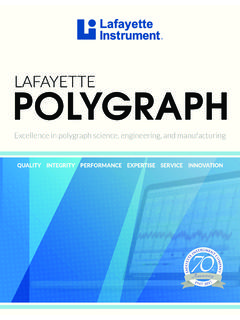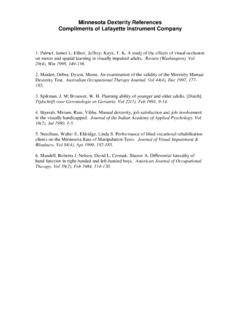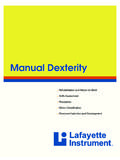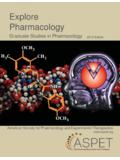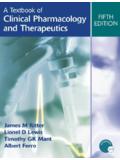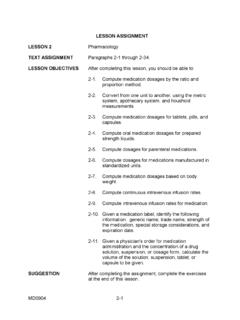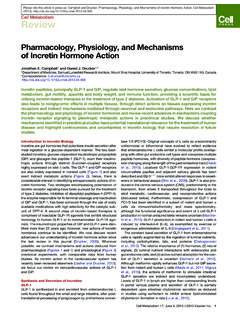Transcription of Journal of Pharmacological and Toxicological …
1 Journal of Pharmacological and Toxicological Methods 64 (2011) 1 6. Contents lists available at ScienceDirect Journal of Pharmacological and Toxicological Methods j o u r n a l h o m e p a g e : w w w. e l s ev i e r. c o m / l o c a t e / j p h a r m t ox Editorial Innovation in safety pharmacology testing Pugsley a, , R. Towart b, S. Authier c, d, Gallacher b, Curtis e a Department of Toxicology/Pathology, Johnson & Johnson PRD, Raritan, NJ, USA. b Center of Excellence for Cardiovascular Safety and Mechanistic pharmacology , Johnson & Johnson Pharmaceutical Research and Development, Division of Janssen Pharmaceutica NV, Turnhoutseweg 30, B-2340 Beerse, Belgium c LAB Research Inc.
2 , 445 Armand Frappier, Laval, QC, Canada H7V 4B3. d Facult de m decine v t rinaire, Universit de Montr al, Box 5000, St-Hyacinthe, QC, Canada J2S 7C6. e Cardiovascular Division, King's College London, Rayne Institute, St Thomas' Hospital, London SE17EH, UK. a r t i c l e i n f o a b s t r a c t Article history: This issue of the Journal of Pharmacological and Toxicological Methods (JPTM) is themed. It is the eighth in a Received 18 May 2011 series, arising from the Annual Safety pharmacology Society (SPS) meeting. The SPS is now in its 10th year as Accepted 19 May 2011 an independent branch of biological sciences (distinct from pharmacology and toxicology) and is the primary forum for driving advances in safety pharmacology .
3 The theme of the meeting and this Journal issue is Keywords: innovation, and the focus is non-clinical safety assessment of new chemical entity (NCEs). The content is hERG. Stem cells informed by regulatory guidance documents (S7A and S7B) prior to rst in human (FIH) studies. The High de nition oscillometry manuscripts cover a broad spectrum of safety pharmacology topics from theory to practice, with interrogation Cardiac slide of state-of-the-art techniques, and pro ling of methods that are in development for safety assessment. Safety Philosophical and strategic issues are addressed, with consideration of the use of novel methods for ICHS7A population pharmacokinetic (PK) analysis, abuse liability, electrocardiogram (ECG) analysis algorithms, in vitro cardiac slice preparations, human pluripotent stem cells, and a brief discussion regarding the assessment of changes in the QRS complex of the ECG indicative of drug-induced blockade of cardiac sodium channels.
4 Safety pharmacology methods continue to evolve. 2011 Elsevier Inc. All rights reserved. 1. Introduction pharmacology as an independent branch of biological sciences (distinct from pharmacology and toxicology). This issue of JPTM focuses exclusively on safety pharmacology The manuscripts herein cover a broad spectrum of safety (de ned as those studies that investigate the potential undesirable pharmacology topics. In some articles, discussion of important issues pharmacodynamic effects of a substance on vital physiological func- concerning the current regulatory environment is included.)
5 The tions in relation to exposure in the therapeutic range and above) and manuscripts in this issue of JPTM also highlight novel areas where associated non-clinical methods (Bass, Kinter, & Williams, 2004; safety pharmacology may have greater impact in the future. We Pugsley, Authier, & Curtis, 2008; Food & Drug Administration, encourage further discussion of key issues, particularly consideration 2001). This is the 8th consecutive year the Journal has published a of the predictiveness of the non-clinical assays described. themed issue on this fundamental topic for the Pharmaceutical Industry.
6 The issue interrogates methods and models that have been 2. Themes developed speci cally for the assessment of the safety pro le of NCEs, as required according to ICH guidelines (see S7A and S7B for details), Abuse liability testing prior to conduct of FIH studies ( Food & Drug Administration, 2001, 2005). The manuscripts that follow derive from presentations Abuse liability testing has emerged to the forefront of safety made at the recent Safety pharmacology Society meeting in Boston, pharmacology in recent years due to the development of several MA (for a comprehensive overview of the meeting, see Cavero, 2011).
7 Guidelines and discussion documents from regulatory authorities in The Society is now in its 10th year, and it de nes and shapes safety the US and Europe (Markgraf & Kallman, 2009; Moser, Wolinsky, Castagn , & Duxon, 2011). Increasing concern about prescription drug abuse and the withdrawal potential of many common drugs have prompted development of non-clinical and clinical evaluation pro- Corresponding author at: Department of Toxicology/Pathology, Johnson & Johnson PRD, OMP 2273, 1000 Route 202 South, Raritan, NJ 08869, USA. Tel.: +1 908 704 4148;. cedures (Moser, Wolinsky, Castagn , et al.)
8 , 2011). A need for such fax: +1 908 635 3977. assessment is made clear, particularly for all new CNS-active E-mail address: ( Pugsley). medicinal products (parents + metabolites) that can cross the blood 1056-8719/$ see front matter 2011 Elsevier Inc. All rights reserved. 2 Pugsley et al. / Journal of Pharmacological and Toxicological Methods 64 (2011) 1 6. brain barrier (BBB), interact with central targets and precipitate activity meter. Both systems determine movement and pattern of an abuse liability potential. Thus, non-clinical testing should result movement. Using caffeine and chlorpromazine in rats, the authors in data derived from a robust, fundamentally sound set of studies found that both systems exhibited similar sensitivities in determina- that provides for a complete assessment of drug abuse potential for a tion of drug-induced changes in locomotor activity (Lynch et al.
9 , NCE. 2011). Thus, addition of automated systems could aid in ease of Abuse liability potential is assessed from information obtained by assessment in CNS adverse effect liability frontloading studies. two-tier evaluation (European Medicines Agency, 2006, 2008; Food & Drug Administration, 2010). The rst tier evaluation compares Safety biomarkers the pharmacology of the NCE to drugs of known abuse potential. In vitro receptor binding studies determine if the NCE interacts with A biomarker is de ned as a characteristic that is objectively receptors associated with drug dependence ( , GABA, opioid and measured and evaluated as an indicator of normal biological dopamine).
10 Additional functional cellular assays (measuring neuro- processes, pathogenic processes, or pharmacologic responses to a transmitter release and second messenger activity) may be conducted therapeutic intervention. (NIH Biomarkers De nitions Working to determine the nature of the interaction ( , whether the drug is an Group, 2001). A simpler de nition is a variable that is used as a agonist or antagonist). Thus, in vitro binding and functional cellular surrogate for the variable of primary interest (Pugsley et al., 2008), studies conducted as a part of early development can provide signals , QTc (prolongation) for torsades de pointes (TdP) liability.

